Birds have the ability to see and distinguish different colors, which helps them identify their fellow specimens. Colors also help birds to attract potential mates and to capture attention while courting (i.e., courtship displays).
Birds’ colors help them camouflage and protect themselves against potential predators. These attributes of color presence in birds lead them to be one of the most colorful creatures on earth.
Birds have brilliant, vivid, and colorful feathers, and who doesn’t love bird-watching? So, we have come up with a new article on 10 stunning Red, White, and Blue birds. These three colors, when present together on any bird, make it exceptionally majestic.
Below is a list of 10 birds that are Red, White, and Blue in color.
10 Stunning Red, White, and Blue Birds
1) Red Naped Trogon
Firstly, on the list, we have Red Naped Trogon, which belongs to the family Trogonidae. They are “non-migratory” or “sedentary” birds; they reside in primary, saturated lowland evergreen forests. Besides, they’re also found in peat-swamp forests, bamboo grooves, and cocoa and coconut plantations.
Red naped trogons are a sexually dimorphic species, and males are brighter than females. They have a mustard color on the dorsal side.
They have bright red color on the ventral side and black color on the neck and head, and the undertail is white and black. These birds also have a white color line on the breast. The blue color on the bill, encircling the eyes, looks eye-catching.
They have compressed bodies; in fact, Trogonidae have only a 3 percent ratio of leg muscle to body weight, which is the lowest known ratio of any bird.
They do defense against predators by sitting still; they lack much activity; and can rotate their heads like owls and keep watch on any potential attackers. Furthermore, they are insect-eating birds; but also feed on fruits. Their predators are some predatory mammals and hawks.
- Scientific Name: Harpactes kasumba
- Size: 32 cm (12.5 inches)
- Location: Brunei, Indonesia, Malaysia, and Thailand
2) Eastern Bluebird
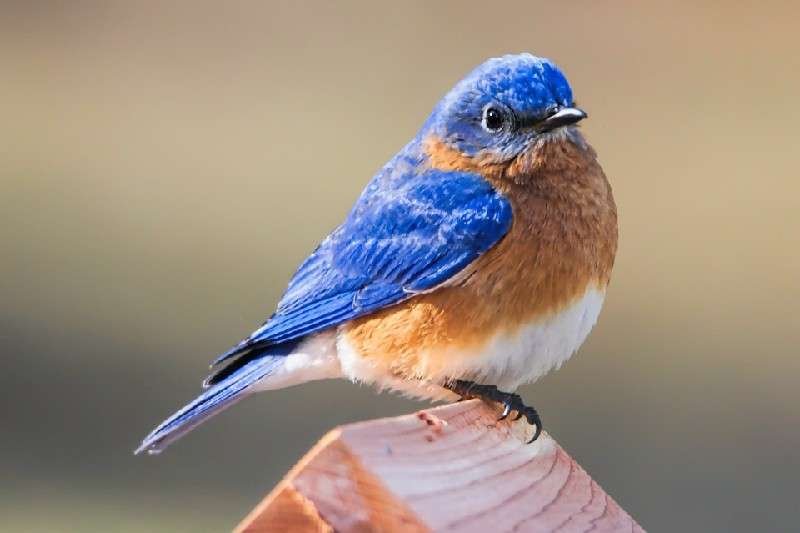
Next on the list of Red, White, and Blue Birds is the Eastern Bluebird. This bluebird is a thrush that belongs to the family Turdidae. These birds are migratory thrushes and spend their winters in the Southeastern United States and Mexico.
They have copper-red colored breasts that extend from the neck to their tails. The undertail is blue and white and has a blue dorsal side. Their head is also blue, and the upper side of the tail has some black feathers too.
Eastern Bluebirds are small birds that feast upon insects, other invertebrates, and fruits.
Mature females lay 3–7 light-blue or white-colored eggs and typically raise two broods per season.
They inhabit open woodlands with patchy vegetation, farmlands, and large trees like orchards. They always sit with an alert, defensive posture.
- Scientific Name: Sialia sialis
- Size: 16–21 cm (6.3–8.3 inches)
- Location: North America
3) Crimson Rosella
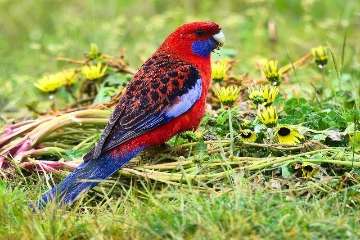
The Crimson Rosella is the first parrot on this list of Red, White, and Blue Birds, which are commonly found in coastal and mountain forests. They tend to live in forests and woodlands and reside in wetter places. They are “non-migratory” or “sedentary” birds.
These birds are mainly red; the red color is present on the head, neck, belly, and in dorsal feathers. They have a blue color on their wings and nape.
Their beak is white, and their tail also has some hues of white. Their flanks are black, and their wings also have markings in black; black spots are also visible on the dorsal side.
Rosellas forage in flocks of up to 20 individuals. They usually forage in trees, bushes, and on the ground. Although they feed on fruits and seeds, they’re of no use as seed-spreaders because they crush and destroy the seeds while feasting.
Their eggs are shiny white, and they lay 3–8 eggs in a period of 2.1 days.
- Scientific Name: Platycercus elegans
- Size: 36 cm (14 inches)
- Location: Eastern and Southeastern Australia
4) Great Spotted Woodpecker
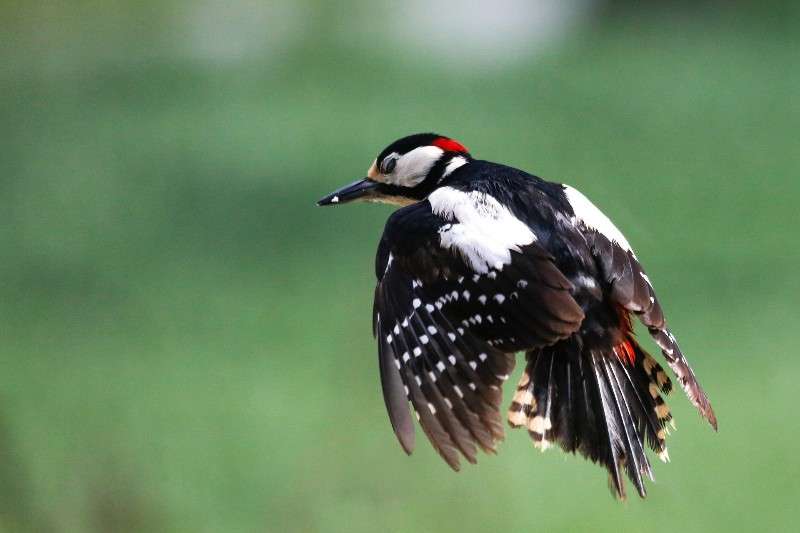
As we can infer from the name, these species of birds peck or chisel in the tree to create nest cavities and feed on the sap or insects present there. In this way, they also help prevent trees from getting injured by ants, caterpillars, and borers.
The forehead, supercilium, and ventral side of these birds are white. They have white color spots on glossy blue-black dorsals.
Males have a crimson-colored nape and a red undetail. The feathers are barred with black and white. They generally have a spotted appearance.
The spotted woodpecker spends its entire life in trees, so it inhabits tropical, temperate, and subtropical moist lowland forests.
They lay 4–6 glossy eggs; the males also incubate the eggs at night, and both partners brood and feed the chicks.
- Scientific Name: Dendrocopos major
- Size: 20–24 cm (7.9–9.4 inches)
- Location: The Palearctic, including parts of North Africa
5) Cuban Trogon
The Cuban Trogon is named “tocororo” in Spanish, which is based upon its repeated call,“toco-toco-tocoro-tocoro,” which is so pleasantly sounded.
The Cuban Trogon is a very colorful bird. It has layers of colors on its feathers which are difficult to distinguish, and has an olive green to blue-green color back, a dark metallic blue head, and a bright crimson red belly.
It has black and white barred wings. Its lower belly and under-tail coverts are also red. Its cheek, breast, and upper belly are white, and the undertail is gradually colored with a repeated pattern of bluish-black and white color.
These birds like to live in humid, shady areas, which is why they inhabit; both primary and secondary forests, shrublands, and smaller woodlands near water sources.
They usually forage in trees and feed on insects, fruits, and buds.
- Scientific Name: Priotelus temnurus
- Size: 23–28 cm or (9.1–11 inches)
- Location: Cuba
6) Red-billed Blue Magpie
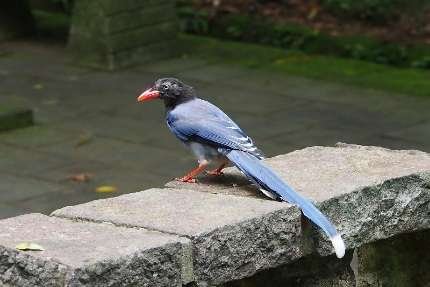
The Red-billed blue magpie is a type of crow that belongs to the family; Corvidae. It is one of the longest corvidae, with a very long tail. Their name is Red-billed blue magpie since they have a red color bill.
The nape, head, face, and breast are completely black, with a bluish spotting on the crown. The shoulders, belly, dorsal part, and upper tail are completely blue. It’s under tail coverts are grayish-white, and the undertail is striped in black and white. The legs and beak are bright red.
They inhabit the evergreen forests and scrub of hilly and mountainous regions and can also be seen in urban spaces. The nests of these birds are relatively shallow, and they nest in naked trees and large shrubs.
As blue magpies are a type of crow, they rob nests of eggs and chicks. Their diet consists of a wide range of foods, including invertebrates, fruits, seeds, and other small animals.
Usually, they lay up to 3-5 eggs.
- Scientific Name: Urocissa erythrorhyncha
- Size: 65–68 cm (25.5–27 inches)
- Location: Indian Subcontinent
7) King Bird of Paradise
The King Bird of Paradise is considered to be the only species in the genus Cicinnurus by the IOC checklist. It’s a passerine bird that belongs to the family Paradisaeidae.
They have distinguishing green and white colored pectoral plumes and a yellow color beak, bill, and forehead. Their head, back, neck, nape, and upper tail are maroon red to orange in coloration.
The breast has a black color stripe, and the belly is completely white. Totally blue-colored legs are seen.
Although beautiful, they tend to be isolated and are loners, and only spend time together while mating. They do a lot of body posturing, pendulum-like swinging, feather manipulations, and intense vocalization in their courtship display.
Their average litter size comprises two eggs. They inhabit disturbed and tall Secondary forests, forest edges, Lowland Rainforests, and Gallery Forests.
- Scientific Name: Cicinnurus regius
- Size: 16–19 cm (6.3–7.5 inches)
- Location: New Guinea and surrounding Islands
8) Victoria Crowned Pigeon
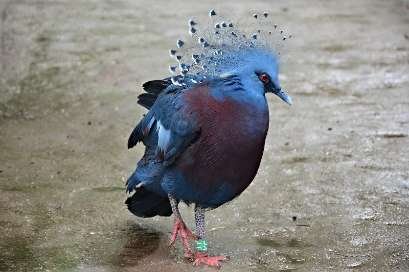
The Victoria Crowned Pigeon got its name from the beautiful blue-colored, lace-like crest feathers, which look like a crown. This pigeon has a maroon or purplish-red breast. The plumage is gray-blue, and the wing is blue with purple edges.
They make a loud clapping sound while taking off, and their mating consists of a deep hoota-hoota-hoota-hoota-hoota sound.
These birds usually inhabit lowland, sea-level areas, such as swamp forests and sago forests. But sporadically, they may venture up into the hills. They have a habit of flying from the sea up to the trees nearly every day.
They walk on the forest floor searching for food, such as fallen fruits and their favorite, figs. Mature females lay one large egg per litter in a well-built nest.
- Scientific name: Goura victoria
- Size: 73–75 cm (29–30 inches)
- Location: Northern New Guinea and surrounding Islands
9) Velvet Fronted Nuthatch
The Velvet fronted Nuthatch is the second passerine bird on this list. They got their name from the way they open the nuts by jamming them into trees and hammering on them until it opens from their bill.
They are small birds with shorter tails and powerful bills and legs. It is violet-blue on the upper side and beige color underside.
Their iris is pale and yellow and is easily distinguished from the rest of their bodies.
Their beak, bill, eye ring, and legs are red, and the forehead is black. They have a whitish throat. The Black color is also present on the wingtip and the secondaries.
They inhabit forests with dense vegetation of trees, like deciduous forests, evergreen forests, etc.
These birds feed on insects present in the bark of trees and forage on trees. Their powerful claws allow them to jerkily move up and down the tree trunks and branches.
They nest in tree cavities and gaps made by woodpeckers or barbels.
Their eggs are white with red or purplish spots, and they lay 3–6 eggs per litter.
- Scientific Name: Sitta frontalis
- Size: 12.5 cm
- Location: Southern Asia
10) Malachite Kingfisher
The Malachite Kingfisher is a river kingfisher that can be identified by their sword-like bills, which they use to spearfish by swooping down and diving into the water. They also feed on aquatic insects and crustaceans.
This characteristic also limits them from residing near slow-moving streams or ponds.
These are smaller in comparison to other kingfishers. They have a metallic blue color upper part. The face and sides are bronze-red in color with white stripes extending from the chin down to the under tail coverts.
They have distinct blue and black colored feathers on their crown. They nest in a tunnel on sandy banks, usually around water.
- Scientific Name: Corythornis cristatus
- Size: 13 cm (5.1 inches)
- Location: Sub-Saharan Africa
Here, we conclude our article on the list of most beautiful Red, White and Blue Birds worldwide. We hope you like our post. We will be back with another exciting article. Till then, stay tuned with us and read the articles mentioned below.
Reference: Wikipedia; National Geographic- Bird pictures and facts; Pinterest
Also Read:

Hey there! I’ve been the kid who used to love watching all the science stuff and that fascination lead me to choose Zoology as my Major in Graduation. I’m a self-taught writer and spend my time writing scintillating content on animals. I love observing animals behavior and their bond with humans. I want to give my point of view regarding animals i research about. I had done several projects on animals during my graduation and learned their behavior thoroughly.


Comments are closed.